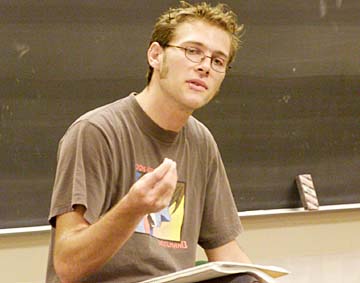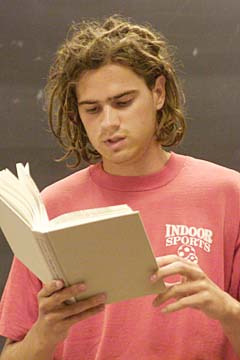

View from the Pew
A look inside Hawaii's houses of worshipBy Mary Adamski

|
Death 101 While state legislators wove their religious beliefs and personal anecdotes into rhetoric about a physician-assisted suicide bill Thursday, another group across town was winding down its months-long discussion about death.
Anecdotes, verse and songs help
students frame their viewpoints
on life's denouementMost of the students in the University of Hawaii "Death and Dying" class were every bit as personally and passionately engaged in the topic as the lawmakers. But they were also better attuned to each other's views thanks to a shared exploration of the subject that included tears and tales of deaths and illnesses in their own lives.
"Humans are the only animal capable of contemplating their own death. We recognize death, and yet we perform all sorts of intellectual gymnastics to try to skirt it, to deny it," said University of Hawaii Religion Department Chairman Cromwell Crawford.
The class is in the religion curriculum, but for about 60 percent of the semester, the professor led his students to medical resources -- a book on euthanasia, articles from medical journals and video interviews with people nearing death. In recent sessions, he presented the end-of-life teachings of Christian, Jewish, Buddhist, Muslim and Hindu religions.
"For a believer, death is the beginning of life," he said. "For an atheist, death is the end of life. For an agnostic, death is the sound of silence."

|
"In the Western world, we are informed by religion that humans were created by God. We see ourselves as separate from the rest of nature," he said, and that is a barrier to seeing death in the natural process of change. "There is death in the process, but the process does not die."Rather than forcing a memorized regurgitation of facts, Crawford opened the floor for student conclusions and observations, and there was no right or wrong viewpoint. "How many people go through life ... thinking simply emotionally and make the responses they've learned." That's not sufficient in professor Crawford's classroom.
Students took over the hour for a midterm show-and-tell performance featuring music and poetry readings.
The course, originated a generation ago by religion professor emeritus Mitsuo Aoki, has developed a reputation that leads some students to seek the personal experience -- "a little like group therapy," was one man's remark -- aside from the credits earned.
Shenna Fortner needed the credits for graduation, but she said, "This class has affected the quality of my relationships. I know how to be more compassionate. I take time to say something nice when I part with someone."
"The class turned out to be so much real-world application, not what I expected," said Damien Nemire-Pepe, a philosophy major from Hunter College here for a year's studies. "I thought it would be more philosophical, but the class is really personal. It brought me to an interesting place."
Nemire-Pepe said "minimizing religion was good. Otherwise it gets to be about ideologies, and people sit inside their ideology. Nothing is learned."
Palana Love Hilton said: "This class forced me to acknowledge death as a reality, I'm so open to death, to talk about it. It made me comfortable with it," she said. Hilton told the class about applying that new insight when she felt free to console a grieving acquaintance.
Her practical introductory comments were in marked contrast to the anguished song she sang. "These Thoughts," which she composed after Sept. 11 because "I felt helpless," contains the refrain: "I don't know a thing of life and love and liberty and such. I want to take this world and shake it up."
Ray Forbes played Japanese "gagaku" music on his flute, haunting minor tones that would be heard at Buddhist and Shinto funeral ceremonies. Gray Grisham found something that "put a human face to an institutional form of dying" in a Miller Williams poem titled "Some lines finished just before dawn at the bedside of a dying student; it has been snowing all night."
Nemire-Pepe read an Emily Dickinson poem: "I heard a fly buzz when I died." He said, "Everybody imagines that last moment of light and God and expects this space of grandeur ... but it is as real as a fly buzzing in the room."
Lyndi Ravenlock was one of a few who brought their faith to the classroom discussion. Her performance was a reading from the Book of Revelations. "The body is not just a body. We have a soul and a spirit," she affirmed. A psychology major, she intends to become a grief counselor. "I'm a Christian. ... It gives me a different perspective," she said later. "I don't think death should be a taboo subject. I want death to be more open."
Of course, the subject of physician-assisted suicide came up. "It goes against everything I believe in," said Ravenlock.

|
"People need to be allowed personal freedom ... including the right to take yourself out of suffering," said Nemire-Pepe. But "you can't go just because you have a bad day."Dr. Roselina Lianto, a Taiwanese doctor on sabbatical, said, "This class is about the spiritual but not religion. I took it because the perspective is not clinical. People expect a doctor to tell them about dying, but we doctors don't know. I have a changing attitude -- I want to listen and learn from patients."
Lianto and her sister, Malia Lianto, sang a song that was a top hit in Taiwan a few years ago.
A story by a youth whose girlfriend died, "it was a miracle that it became popular. In our culture we seldom talk about dying. This was a first time that young people wrote about dying and grieving, that people accepted the sentiments. It says it is OK to try and remember after she's gone."
Jennifer Larsh, who is majoring in comparative thought, liked the class because it was not heavy on religion. "It just made us free to talk about so many things. I'm surprised about how it affected me. I've gotten choked up" by someone else's anecdote, and "all of a sudden, you realize you feel strongly about it."
RELIGION CALENDAR
Mary Adamski covers religion for the Star-Bulletin.
Email her at madamski@starbulletin.com.